In recent years, there has been a notable evolution in SERP results. Google has introduced diverse SERP features designed to engage customers at various points in their buying journey.
Within this dynamic landscape, brands encounter difficulties in distinguishing themselves in the SERP. However, a powerful tool for enhancing visibility exists: Featured snippets. In this article, we will be discussing Google Featured Snippets in Details.
Table of Contents: Show
- What are Featured Snippets?
- How do Featured Snippets work?
- Are featured Snippets Paid?
- What is the importance of Featured Snippets?
- Benefits of appearing on Featured Snippets
- What are the types of Featured Snippets?
- How to Optimize for Featured Snippets and Outrank your Competitors
- Why are my featured snippets disappearing
- Conclusion
What are Featured Snippets?
Google Featured Snippet is a search box that shows the precise answer by highlighting the texts that Google deems relative to the search query. Also known as “Position Zero”, Google Featured Snippets are displayed at the top of Google’s SERP.
Being ranked on the Featured snippet increases the likelihood of getting better visibility and clicks. The reason is simple. It features concise and descriptive text in the form of paragraphs, lists, tables, videos, and carousel. These texts are extracted directly from the indexed web page.
For example, GrowByData recently appeared in a featured snippet for the search query “How to Optimize for People Also Ask.”
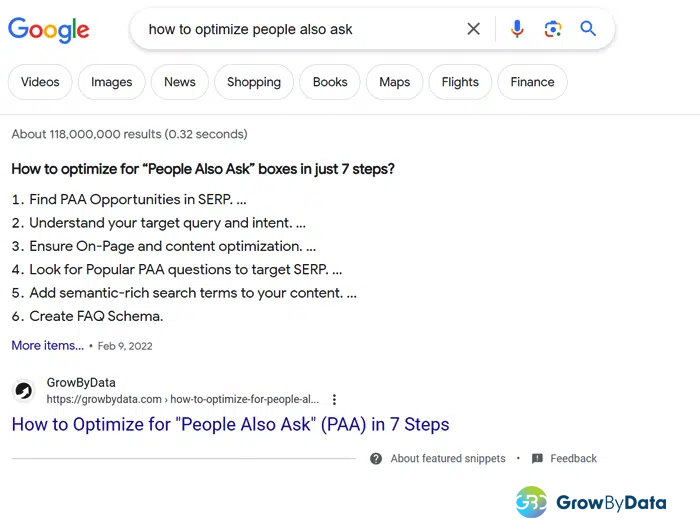
The search box shows the precise answer by highlighting specific texts that Google deems reflective of what the search query is looking for in bold. This feature helps users find the exact answer to their queries and meet their specific needs.
Benefits of Google Featured Snippets
The Featured Snippet, appearing as the top result on the SERP, offers various advantages as outlined below.
1. Achieve SERP Position “Zero” Ranking
By securing the Position ZERO ranking, Google Featured Snippets allow you to attain more above-the-fold visibility, resulting in increased impressions and a higher likelihood of attracting clicks to drive traffic to your website. Above-the-fold coverage can be called important search metrics for search managers.
2. Target Users at the Top of the Keyword Funnel
Users frequently search for definitions, meanings, how-to videos, or even steps to find answers to their queries. Usually, the users who are at the top of the funnel gather information and are aware of various brands and businesses.
Featured Snippets serve as an effective method to reach and target these users by offering concise and straightforward answers and enabling them to further explore the topic if they desire.
3. Maximize Your Website Traffic with Mobile Text and Voice Queries
Voice assistant apps like Siri, Google Assistant, Alexa, and Cortana will make searching even more convenient in 2024. The rising popularity of voice search among mobile users presents an opportunity for brands and businesses. Notably, these AI apps rely on Google Featured Snippets to provide accurate answers to users’ voice and text queries, leading to increased organic traffic and potential leads for mobile devices.
4. Aim to Target Different Feature Snippets
There are four distinct types of featured snippets that brands can focus on to align with various search intents. Each snippet caters to different search intents and offers different ways of presenting information.
By optimizing your content for these different snippets, businesses can increase their online presence. And the perks is that these online presence aligns with different user intents addressing by targeting video, text (paragraph), listicles, and tabular featured snippets, you can effectively address your users’ search queries and engage customers at different stages of the keyword funnel.
5. Target PAA SERP features to capture four unique featured snippets.
The People Also Ask (PAA) feature on Google is becoming increasingly popular in SERPs. It typically displays informational results. By optimizing your content for featured snippets, you can enhance your chances of ranking in the People Also Ask section, even if you don’t appear in the featured snippet itself.
What are the types of Featured Snippets?
Google uses its indexed web pages to automatically select content that matches the type and intent of a search query. Understanding which type of featured snippet is most suitable for your topic enables you to create optimized content with a higher chance of appearing as a featured snippet in the SERP. Below, we will explore the 5 types of featured snippets found in the Google SERP.
- Text or Definition (Short Paragraph)
- Video
- Lists
- Table
- Multiple Featured Snippets
1. Text or Definition
Textual or definition-featured snippets are short paragraphs that provide textual information or exact definitions related to a search query. These snippets typically consist of 2-3 sentences directly addressing the question.
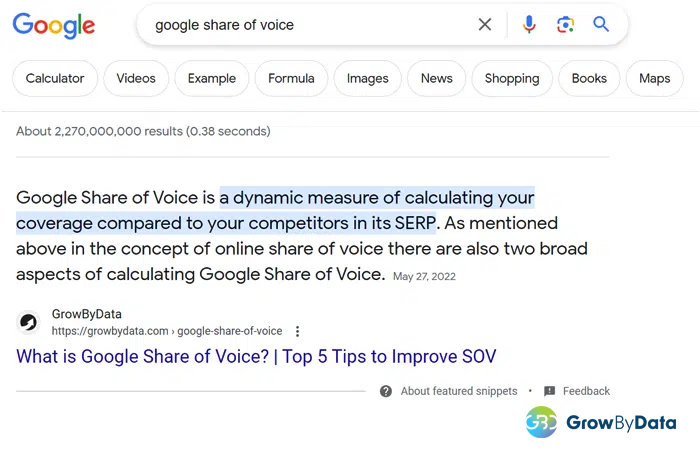
In the provided image, Google highlights the ” definition of the keyword “Google Share of Voice” in a textual or paragraph form. This type of featured snippet is the most common on Google, accounting for approximately 82% of the snippets. It is prominently displayed for search queries that start with “What,” “Who,” “When,” or “Why.”
2. Video
Video Snippets normally transform search results with multimedia from YouTube especially for “how to” queries on Google. They provide valuable information guiding the users to relevant sections of the video using timestamps to ensure precise and engaging responses. Marketers and content creators must optimize their videos so that users can easily and directly access targeted content and information.
Optimized videos efficiently showcase expertise, enhancing online visibility. This intersection of technology and content represents a significant leap in online search and multimedia integration, revolutionizing information access.
The videos that appear on the snippets efficiently showcase the expertise of the content creator which helps in enhancing online visibility. Thus, a Video featured snippet is might important aspect to strive for if you are a video content creator.
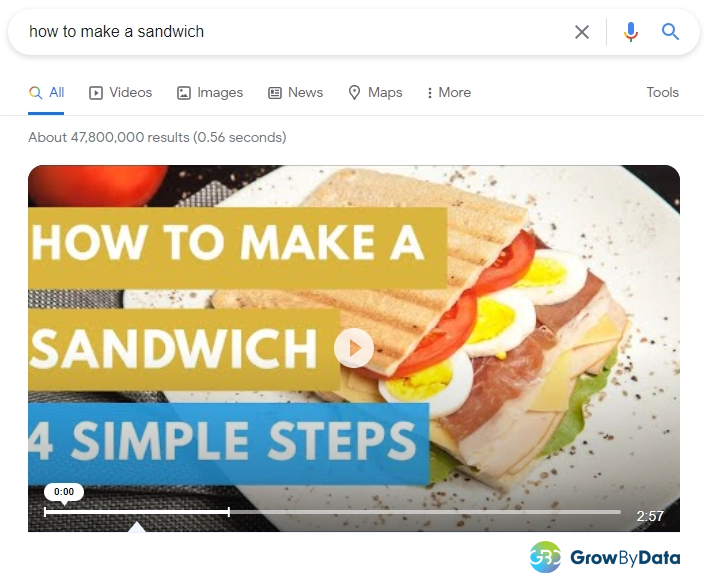
3. Lists
Listicle result is a type of Featured snippet that appears on the Google Search Engine. These results are designed to rank things, provide step-by-step instructions, or present lists related to various search queries. They offer a concise and easy-to-read answer, eliminating the need to go through lengthy paragraphs.
Listicle Featured Result is the second most common type of featured snippet displayed by Google. For instance, when searching for queries like “how to optimize for internal linking” or” how to optimize for people also ask “,” Google may display an organized listicle with clear steps, as depicted below.
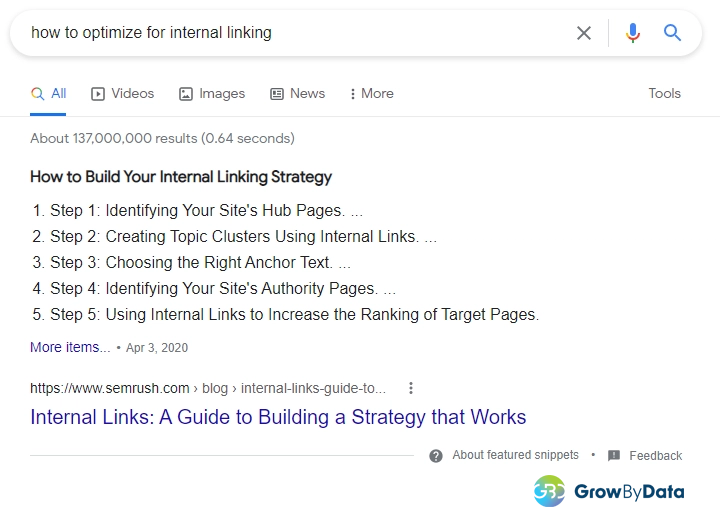
The lists can be ranked if the search query is something like “top 10 romantic movies of 2020”. However, they can also be presented as unordered lists, as shown in the image above.
4. Table
Table types of featured snippets are displayed for comparison queries. Google extracts data from existing content on its web pages and presents them in a tabular format. Tables are organized in rows and columns. You may come across table-featured snippets when searching for prices on a menu, sizes of clothing at a store, or comparing revenues, as depicted in the image below.
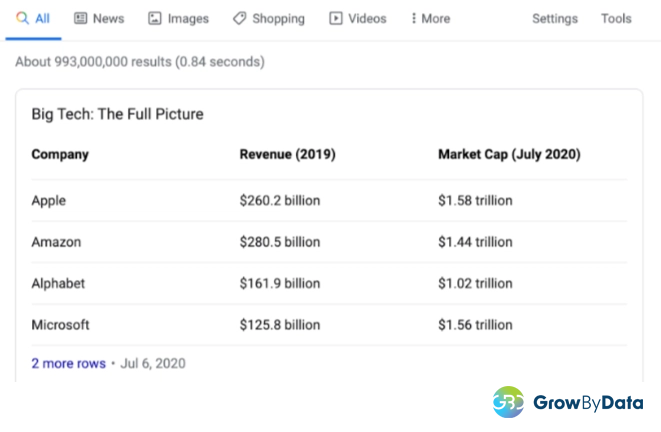
5. Multiple Featured Snippets
Multiple Featured Snippets generally occur when Google or any other search engine is not sure of the intent of the search query. Sometimes multiple results are textual and other times both results are different i.e. textual and listings, textual or images.
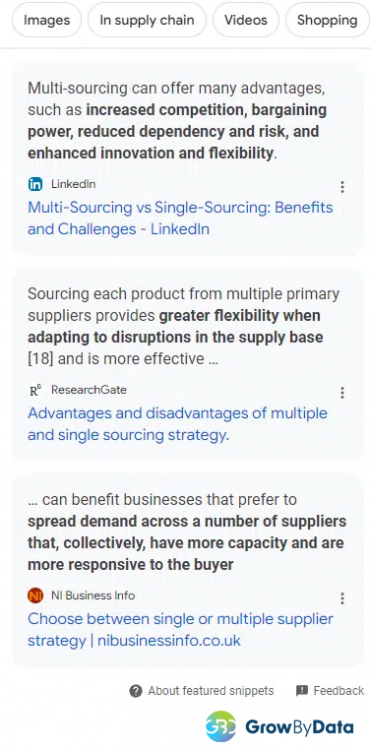
With Google’s constant updates and algorithms, multiple-featured snippets are not a common occurrence, however, they have regularly occurred in Mobile and Smartphones.
How to Rank on Google Featured Snippets?
Featured Snippets are highly valuable to marketers as they are among the most prominent SERP features. However, Google does not disclose the exact methods for ranking Featured Snippets. The decision of whether your content is suitable for display as a featured snippet for a specific search query lies entirely with Google’s search engine algorithm.
Fortunately, there are several strategies and best practices you can implement to enhance your chances of securing featured snippets and attaining this highly sought-after position on the SERP.
Here are some effective best practices that you can utilize to optimize your content and improve your ranking in Google featured snippets.
1. Provide Definitive Answers and information
When a user is looking for a specific answer, they mostly use question search queries. Providing a clear and concise answer to these questions in search queries is crucial specifically for textual or definition FS.
Things to Remember
-
- Keep your answers short and to the point, using around 40-60 words or 250 characters.
- Avoid unnecessary details, background information, or statistics.
Here’s an example:
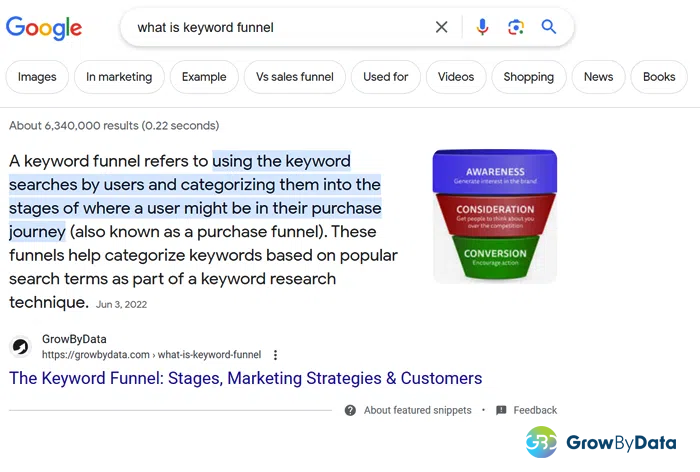
If we observe the image above, Featured Snippets typically contain around 40 words, providing a concise yet informative definition for the search query. For instance, in the case of the query “What is keyword funnel,” the snippet delivers a succinct & concise definition rather than throwing unnecessary information.
2. Provide Accurate Lists (either ordered or unordered lists)
Understanding the searcher’s intent is crucial in optimizing your campaigns for featured snippets. If the user’s intent is to learn about the steps to improve SEO, or how to rank on Walmart, structuring your content as a list can increase your chances of being featured in this SERP feature.
Therefore, it is advisable to provide answers to queries in the form of ordered or unordered lists, especially for topics such as “how”, “top ten”, “best movies/tools”, “benefits”, and more. Listicle Featured Snippets can help to break down dense content into smaller, digestible chunks, making it easier for users to comprehend the list. It is advisable for marketers to use HTML code for ordered or unordered lists.
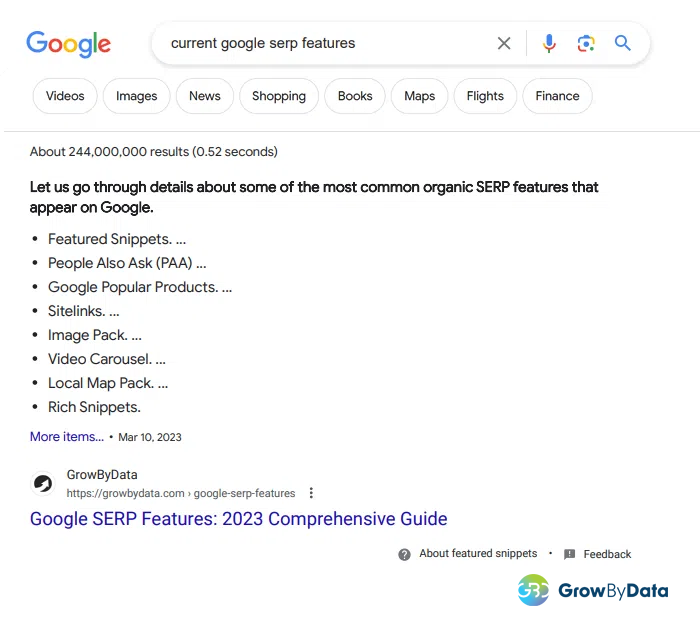
3. Generate higher-quality content than your competitors
Content is a key factor in determining Google’s featured snippet rankings. If your competitor holds a featured snippet position, aim to produce superior content that offers more precise answers, definitions, steps, video content, or any other relevant information to effectively address the search query and provide a better user experience.
Given that users are consistently seeking better content and the Google algorithm strives to deliver an optimal user experience, it is crucial to regularly optimize and update your content. However, it’s important to note that featured snippets are only displayed for results ranking on the first page of search engine result pages.
4. Optimize your Content Hierarchy and Structures
Creating a clear and organized web page is crucial to every search marketer. One of the best ways to achieve an organized web page is by implementing a content hierarchy. This means you need to utilize suitable headings such as h2s, h3s, and h4s to structure any piece of content effectively.
Structured content hierarchy creates a smooth reading experience for your audience. Properly formatted headings provide signals to various search engines about important sections. This strategy increases the likelihood of being featured in a snippet.
To increase the chance of appearing on Google Featured snippet, you need to consider and plan to use question queries within your headings. This SEO tactic involves using FAQ questions in concise headings.
Incorporate questions into your heading tags within your content. Here are a few examples:
-
- “What are featured snippets?”
- “How to optimize your content?”
- “How to conduct pricing analysis?”
When the users and audiences search for these simple questions, there is a high possibility of search engines pulling your structured content directly in Featured Snippets offering simple, and valuable answers.
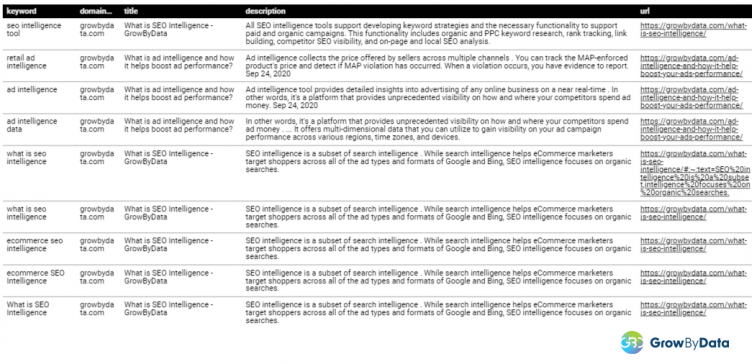
6. Make Videos
To effectively reach your target audience of video consumers, especially those who frequent YouTube, create straightforward videos that provide step-by-step explanations. Additionally, optimize your video descriptions on YouTube to improve visibility and engagement. This will help you rank on Video Featured Snippets.
Frequently Asked Questions
Why are my featured snippets disappearing?
There are multiple factors that can contribute to the disappearance of your featured snippets. Firstly, if your competitors offer more relevant and comprehensive content that better addresses user queries, they may outrank you and take the featured snippet position. Therefore, it’s crucial to regularly optimize your content, analyze your competitors, and keep your content updated. Secondly, Google may choose not to display featured snippets for certain keywords or search queries if it deems them irrelevant or unnecessary based on the search intent.
How do featured snippets work?
When users search for specific queries in formats such as “what, how, top ten, recipes,” Google extracts relevant text from various content sources that can provide answers. Through analysis of its extensive database, Google aims to match the search intent and deliver an enhanced product experience for the user.
Are featured Snippets paid?
No, Google-featured snippets are organic results. Google uses text from indexed web pages to provide concise information directly in search results.
Conclusion
Featured snippets can significantly boost your website’s traffic. While Google designed this SERP feature to provide users with information directly, it’s not always possible to convey all the necessary details in just a few sentences or words. Utilize this guide to optimize your content for featured snippets and improve your authority, credibility, and traffic on Google.
Consider using Search Intelligence Software to track your competitors’ efforts in winning the featured snippet spot. It provides valuable insights into who currently holds the SERP feature for your important keywords, enabling you to create superior content and strategically surpass your competitors.


